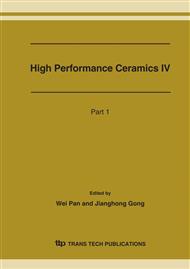p.952
p.955
p.958
p.961
p.965
p.968
p.971
p.974
p.977
Tribochemical Effects of MoSi2 Powder in Ball Milling
Abstract:
The tribochemical effects of MoSi2 powder in the ball milling process have been studied by X-ray diffraction (XRD) and QM-4H milling machine. It has been found that the intensity of diffraction peak of MoSi2 powder is continuously decreased and the width increased with the increase of milling time. Specifically, the crystallite size decreased largely in the early stage of milling. Contrary to the above, the microstrain and the effective temperature factor increased considerably. After ninety hours of milling, the crystallite size had little changes. The relations among the tribochemical effect factors are as follows: the microstrain and the effective temperature factor increase with the decrease of the crystallite size. The microstrain increases with the increase of the effective temperature factor.
Info:
Periodical:
Pages:
965-967
Citation:
Online since:
April 2007
Authors:
Keywords:
Price:
Сopyright:
© 2007 Trans Tech Publications Ltd. All Rights Reserved
Share:
Citation:


